Cinema Teatro Centrale
In the climate of general social and economic recovery in the years immediately following the end of the First World War, Sanremo too became the destination of numerous entrepreneurs and businessmen who wanted to make the most of the city's enviable position to relaunch its tourist image and bring it back to the splendour of the belle époque.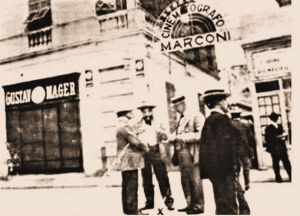 Among them was impresario Aurelio Berardinelli, then owner of a large cinema in Salsomaggiore Terme in the province of Parma, who decided to build a large new theatre and cinema in the very central Via Vittorio Emanuele II (today's Via Matteotti) along the prospect of today's Corso Mombello, on the same land where first the Arena Sisto and then the Parisiana cinema, which later became Marconi and finally Moderno, had been built.
Among them was impresario Aurelio Berardinelli, then owner of a large cinema in Salsomaggiore Terme in the province of Parma, who decided to build a large new theatre and cinema in the very central Via Vittorio Emanuele II (today's Via Matteotti) along the prospect of today's Corso Mombello, on the same land where first the Arena Sisto and then the Parisiana cinema, which later became Marconi and finally Moderno, had been built.
The latter, already owned by the Moraglia family and with its structure still made of wood, had its entrance near Caffè Europèen, open on the Rigolè, as the intersection between today's Via Matteotti and Via Feraldi and today's Corso Mombello was then commonly referred to.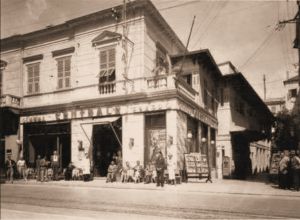 The entrepreneur from Salsomaggiore therefore entrusted the project for the construction of the new building to his fellow citizen architect Guido Tirelli, who in the Emilian city was director of the Municipal Technical Office and chief engineer of the large Belzieri Spa factory. The cement works were entrusted to Ugo Jacazio of Genoa, while the wrought iron was made by the Lombard craftsman Alessandro Mazzucotelli.
The entrepreneur from Salsomaggiore therefore entrusted the project for the construction of the new building to his fellow citizen architect Guido Tirelli, who in the Emilian city was director of the Municipal Technical Office and chief engineer of the large Belzieri Spa factory. The cement works were entrusted to Ugo Jacazio of Genoa, while the wrought iron was made by the Lombard craftsman Alessandro Mazzucotelli.
The official inauguration of the new theatre took place on 20 March 1924. Berardinelli had expressly commissioned the theatre to be used mainly as a cinema, as indeed it was from the very first years, also due to the reduced depth of the stage. And it was precisely for its cinema functions that the Centrale received its first important recognition with the awarding of the Diploma, Grand Prize, Gold Medal and Cross of Honour for Industrial Merit at the First International Exhibition in Rome in 1926.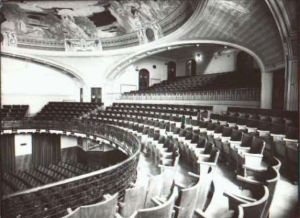 Although it was commissioned for cinema, the Centrale was designed as a real theatre, as is evident from the typical forms of the boccadopera with four proscenium boxes in perfect harmony with the best 19th-century tradition. The horseshoe design of the balconies inserted in the arms of the Latin cross on which the building's plan is developed is also of purely classical inspiration.
Although it was commissioned for cinema, the Centrale was designed as a real theatre, as is evident from the typical forms of the boccadopera with four proscenium boxes in perfect harmony with the best 19th-century tradition. The horseshoe design of the balconies inserted in the arms of the Latin cross on which the building's plan is developed is also of purely classical inspiration.
Within the general decorative scheme of the theatre, in tune with the canons of the most genuine Italian theatrical tradition, the great fresco on the annular band of the dome is particularly noteworthy, depicting Sanremo Trionfante surrounded by centaurs and nymphs in flight amidst lights, solar images and marine scenes, the work of the Tuscan artist Galileo Chini (1873-1956), one of the greatest and most famous interpreters of Italian figurative art in the first two decades of the last century.
At the centre of the dome, a trapdoor opened mechanically at the end of each performance, while between the trapdoor and the graceful figures frescoed by Chini, the motto is engraved: "Canto di Luce l'inesprimibil sogno in Verità tramuta" (Song of Light the inexpressible dream is transformed into Truth), whose obscure meaning has been reasonably interpreted as the truth of the sky opening up after the cinematographic fiction, or dream.
The theatre structure was completed in 1928 with the creation of the large Art Deco façade designed by Pietro Agosti, the engineer and then mayor of Sanremo, who proved to have learned the dictates of the new artistic current imposed by the Exhibition of Decorative and Industrial Arts in Paris in 1925.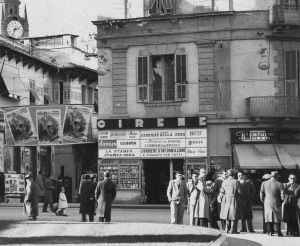 In the first years of activity, the public could access the cinema through a large atrium on the ground floor of the building, located to the left of the courtyard where the current entrance opens. After descending a few steps, one reached the entrance to the stalls, flanked on the left by the staircase used to climb up to the boxes and the two tiers of galleries, while the right side, overlooking the courtyard, housed only the exits.
In the first years of activity, the public could access the cinema through a large atrium on the ground floor of the building, located to the left of the courtyard where the current entrance opens. After descending a few steps, one reached the entrance to the stalls, flanked on the left by the staircase used to climb up to the boxes and the two tiers of galleries, while the right side, overlooking the courtyard, housed only the exits.
Next to the cinema, with which it was in communication but with a separate entrance and foyer (and still well preserved and visible, even if incorporated in the shop at number 97 Via Matteotti), the Tabarin Florida was built and opened to the public in 1929. This was a small nightclub where people could watch variety shows and whose name derives from that of a seventeenth-century French comedian, called Tabar after the type of cloak he wore.
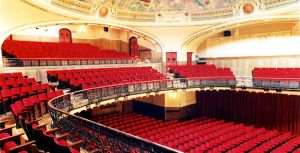 Particularly refined are the small stage enclosed by two naked maidens, supple caryatids made of polychrome painted papier-mâché, the walls and ceiling richly decorated with Art Deco motifs with a Triumph of Cupid in the centre, while the wall opposite the stage features a large painting of Spring, a tribute to Sanremo's mild climate, the main reason for the city's tourist success, by Paolo Rusconi, who was also the author of all the other paintings and decorations in the hall.
Particularly refined are the small stage enclosed by two naked maidens, supple caryatids made of polychrome painted papier-mâché, the walls and ceiling richly decorated with Art Deco motifs with a Triumph of Cupid in the centre, while the wall opposite the stage features a large painting of Spring, a tribute to Sanremo's mild climate, the main reason for the city's tourist success, by Paolo Rusconi, who was also the author of all the other paintings and decorations in the hall.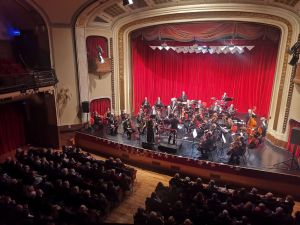 A few years after its inauguration, however, the management of the Centrale by the Salsese entrepreneur Berardinelli was already in crisis, partly due to the fact that the cinema-theatre still lacked a sound system, In the end, Berardinelli managed to avoid bankruptcy only by selling the building in 1933 to the Vacchino company, then managed by Mrs Emilia, widow of the founder Carlo, and her young son Aristide, who were destined to play a major role in the history of Sanremo's theatre and cinema industry. In the years leading up to the Second World War, the entrance and lobby in front of what is now Via Matteotti were converted into premises reserved for commercial activities.
A few years after its inauguration, however, the management of the Centrale by the Salsese entrepreneur Berardinelli was already in crisis, partly due to the fact that the cinema-theatre still lacked a sound system, In the end, Berardinelli managed to avoid bankruptcy only by selling the building in 1933 to the Vacchino company, then managed by Mrs Emilia, widow of the founder Carlo, and her young son Aristide, who were destined to play a major role in the history of Sanremo's theatre and cinema industry. In the years leading up to the Second World War, the entrance and lobby in front of what is now Via Matteotti were converted into premises reserved for commercial activities.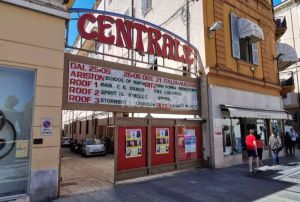 Between June and September 1987 the whole complex of the Centrale was finally subjected to a series of interventions aimed at a careful and scrupulous restoration of the structure through its homologation with the most recent safety regulations and the most modern technical equipment. In particular, the theatre hall, enlarged after the war, was restored to its original dimensions and characteristics, obtaining in the spaces thus obtained a new room used as a video-club.
Between June and September 1987 the whole complex of the Centrale was finally subjected to a series of interventions aimed at a careful and scrupulous restoration of the structure through its homologation with the most recent safety regulations and the most modern technical equipment. In particular, the theatre hall, enlarged after the war, was restored to its original dimensions and characteristics, obtaining in the spaces thus obtained a new room used as a video-club.
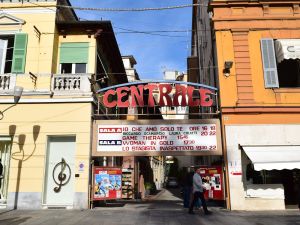 During these interventions, the old Tabarin Florida, which had been downgraded to a warehouse after becoming a billiards room in the early 1950s, was brought back to life. Thanks to the careful restoration, the room has regained its old Art Nouveau splendour, becoming a small cinema and theatre for about one hundred seats, which has taken on the historical name of Cinema Tabarin.
During these interventions, the old Tabarin Florida, which had been downgraded to a warehouse after becoming a billiards room in the early 1950s, was brought back to life. Thanks to the careful restoration, the room has regained its old Art Nouveau splendour, becoming a small cinema and theatre for about one hundred seats, which has taken on the historical name of Cinema Tabarin.
In front of the main entrance of the Centrale there is a flower-bed with the statue of Ondina, created by sculptor Vincenzo Pasquali, like its famous sister Primavera in the Imperatrice promenade, and already located for a long time in the gardens in front of the Morgana beach.
(source: texts by AndreaGandolfo; images from private archive and WEB)




